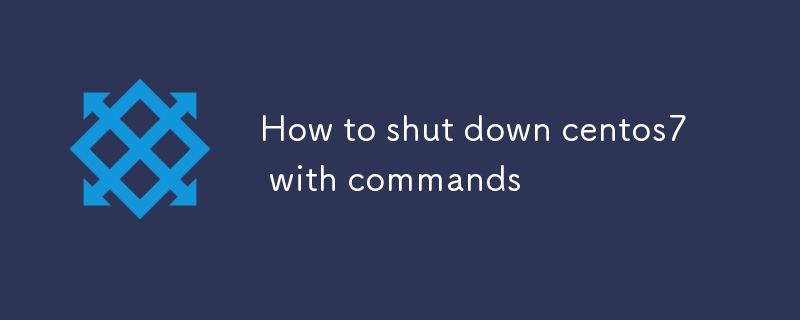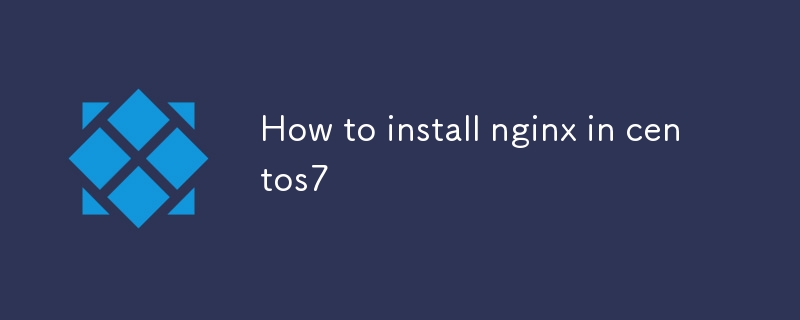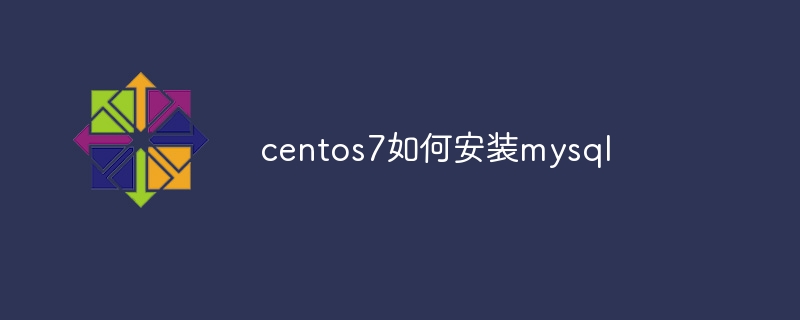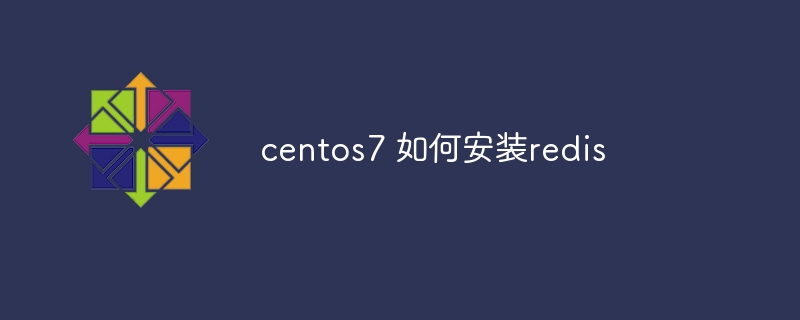Found a total of 10000 related content

Centos7 image download
Article Introduction:CentOS 7 mirror download seems simple, but it actually has hidden secrets. You need to choose the right mirror source, verify the completeness of the mirror, and choose the right version. When selecting a mirror source, speed is the key, and it is recommended to use Alibaba Cloud, NetEase Cloud or Tsinghua University mirroring station. After the download is complete, use MD5 or SHA256 to verify the integrity of the mirror to ensure that the mirror has not been tampered with. Select the minimized installation version or full installation version according to your needs, and pay attention to details such as breakpoint continuous transmission, download tool selection, disk space inspection, etc., so as to easily complete the CentOS 7 image download.
2025-04-14
comment 0
822

Restart centos7 command
Article Introduction:Reboot command is available to restart CentOS 7. The steps are as follows: Open the terminal window and enter the reboot command. Confirm the restart prompt. The system will restart and the boot menu will appear during this period. After the restart is complete, log in with the credentials.
2025-04-14
comment 0
752

How to shut down centos7 with commands How to shut down centos7
Article Introduction:This article details how to shut down a CentOS 7 server via command line. It compares shutdown, halt, poweroff, and init 0, recommending shutdown -h now for a graceful shutdown to prevent data loss. Alternatives are faster but risk data corruption.
2025-03-05
comment 0
1165

How to install nginx in centos7
Article Introduction:This article provides a step-by-step guide to installing and configuring Nginx on CentOS 7 using the yum package manager. It covers installation, dependency management, configuration file editing, and verification methods, ensuring a functional Ngin
2025-03-05
comment 0
639

How to configure network in centos7
Article Introduction:The network configuration of CentOS 7 no longer uses the old ifconfig tool, but instead uses a more powerful systemd-networkd, which manages the network through configuration files. Configuration files ending in .network (for example /etc/systemd/network/eth0.network) specify network settings using the YAML format. Static IP configuration requires specifying address, gateway, and DNS, while dynamic IP configuration requires only one line DHCP=yes. systemd-networkd supports a variety of complex configurations, including multiple IP addresses, VLANs, and Bonding. Need to pay attention to syntax errors
2025-04-14
comment 0
923

How to install mysql in centos7
Article Introduction:The key to installing MySQL elegantly is to add the official MySQL repository. The specific steps are as follows: Download the MySQL official GPG key to prevent phishing attacks. Add MySQL repository file: rpm -Uvh https://dev.mysql.com/get/mysql80-community-release-el7-3.noarch.rpm Update yum repository cache: yum update installation MySQL: yum install mysql-server startup MySQL service: systemctl start mysqld set up booting
2025-04-14
comment 0
949


What are the versions of centos firewalls?
Article Introduction:CentOS7 and above use firewalld as a firewall management tool by default, while CentOS6 and below use iptables. The following is a related introduction: Firewalld firewall installation for CentOS7 and above: If firewalld has not been installed yet, you can use the following command to install: sudoyumininstallfirewalld. Start and set up the power-on self-start: The commands for starting the firewalld service and setting the power-on self-start are: sud
2025-04-14
comment 0
987

How to replace Alibaba yum source in centos7
Article Introduction:This article details how to switch a CentOS 7 system's yum repository to Alibaba Cloud's, improving download speeds and reliability. It covers downloading the repository file, updating the yum cache, and prioritizing the new repository. Reversion
2025-03-05
comment 0
940

How to easily configure Redis clusters in CentOS
Article Introduction:Configuring a Redis cluster on CentOS can be achieved through the following steps. Here is a basic guide, assuming you have CentOS7 or higher installed and Redis is already installed. Prerequisites Install Redis: sudoyumininstalllepel-releasesudoyumininstallredis Start Redis service: sudosystemctlstartredissudosystemctle
2025-04-14
comment 0
1113

How to shut down and restart centos7 shutdown and restart command
Article Introduction:This guide details safe shutdown and reboot methods for CentOS 7 servers. It emphasizes using the shutdown command for its flexibility and ability to schedule restarts, contrasting it with the less-flexible reboot and halt commands. Safe practices
2025-03-05
comment 0
774

The Discontinuation of CentOS: Understanding the Factors
Article Introduction:The reason why CentOS stopped maintaining is RedHat's strategic change. User response strategies include: 1. Migrating to other distributions, such as UbuntuServer, Debian or RockyLinux; 2. Continue to use CentOS7 until June 2024; 3. Turning to CentOSStream; 4. Build solutions, such as custom distributions based on RHEL or using container technology.
2025-04-24
comment 0
543

What is the command to start, stop, or restart Nginx?
Article Introduction:To start, stop or restart Nginx, the specific commands depend on the system type and installation method. 1. For modern systems that use systemd (such as Ubuntu16.04, Debian8, CentOS7), you can use: sudosystemctlstartnginx, sudosystemctlstopnginx, sudosystemctlrestartnginx, and use sudosystemctlreloadnginx after configuration changes; 2. For old systems that use SysVinit, use the service command: sudoservicenginxstart,
2025-06-18
comment 0
704

How to install the latest software packages in CentOS
Article Introduction:There are many ways to install the latest software packages on CentOS system. This article will introduce in detail several commonly used methods to help you easily manage system software. 1. Utilize system package manager: yum or dnfCentOS7 uses yum, while CentOS8 and above use dnf as the default package manager. The two are similar to using: CentOS8/9(dnf)sudodnfupdate#Update all installed packages sudodnfininstall#Installing the specified package CentOS7(yum)sudoyumupdate#Update all installed software
2025-04-14
comment 0
994

How to choose the PyTorch version on CentOS
Article Introduction:When installing PyTorch on CentOS system, you need to carefully select the appropriate version and consider the following key factors: 1. System environment compatibility: Operating system: It is recommended to use CentOS7 or higher. CUDA and cuDNN:PyTorch version and CUDA version are closely related. For example, PyTorch1.9.0 requires CUDA11.1, while PyTorch2.0.1 requires CUDA11.3. The cuDNN version must also match the CUDA version. Before selecting the PyTorch version, be sure to confirm that compatible CUDA and cuDNN versions have been installed. Python version: PyTorch official branch
2025-04-14
comment 0
1211

How to change the default runlevel (target) in CentOS 7/8/9?
Article Introduction:In CentOS7, 8 and 9, the default run level has been replaced by the target unit, but the operation logic is similar. 1. Check the current default run level using the command systemctlget-default; 2. Modify the default run level using the command sudosystemctlset-defaultTARGET name; 3. Temporarily switch the run level using the command sudosystemctlisolateTARGET name; 4. Modify only affects the next startup, and the remote server usually defaults to multi-user.target; 5. If the graphical interface component is not installed, setting the graphic.target may cause the startup to fail; 6. You can use r
2025-06-27
comment 0
1005

How to search for a package in the CentOS repositories?
Article Introduction:The most common way to find software packages in CentOS systems is to use yum or dnf tools. 1. For CentOS7 and earlier versions, use the command "yumsearch keyword" to search for packages containing keywords, such as "yumsearchnginx"; 2. For CentOS8 and newer versions, use the dnf command, such as "dnfsearch keyword", to support more precise matching, such as "dnfsearchname:python", and you can also search for multiple keywords such as "dnfsearchnginxphp" at the same time; 3. After searching for the target package, you can view the detailed information through "yuminfo package name" or "dnfinfo package name" to confirm the version
2025-06-28
comment 0
935

How to configure a static IP address on CentOS 7 using ifcfg files?
Article Introduction:To configure the CentOS7 static IP address, you need to edit the ifcfg file of the corresponding network card. 1. First confirm the network card name such as ens33 through iplinkshow or ls/sys/class/net; 2. Edit the /etc/sysconfig/network-scripts/ifcfg-ens33 file to set BOOTPROTO=static and fill in IPADDR, NETMASK, GATEWAY and other parameters; 3. After saving, restart the network service to make the configuration take effect; 4. Use the ipaddrshow and ping commands to verify whether the configuration is successful. Be careful to avoid IP conflicts and restart the network service after modification. If you use NetworkM
2025-07-02
comment 0
188

How to update all packages on a CentOS system?
Article Introduction:To update all software packages on the CentOS system, you can use yum (CentOS7) or dnf (CentOS8 and above). The specific steps are as follows: 1. Check for available updates and use "sudoyumcheck-update" or "sudodnfcheck-update" to list the packages to be updated; 2. Execute the system-wide update, and use "sudoyumupdate-y" or "sudodnfupgrade--allowerasing" commands to upgrade, where the -y parameter is automatically confirmed, and --allowerasing allows the deletion of conflicting packages; 3. If the update involves a new kernel, the system needs to be restarted to take effect, and "unam can be used to use "
2025-06-25
comment 0
183



















